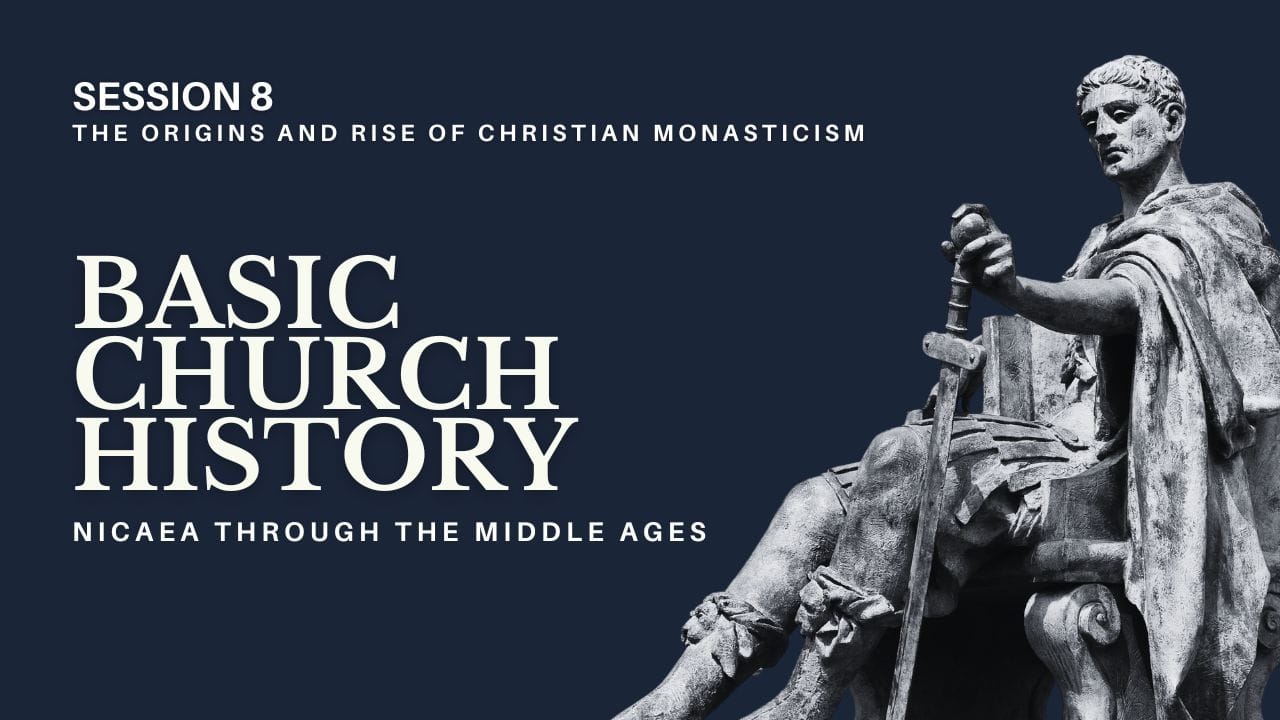Sunday School Review: Basic Church History: Nicaea through the Middle Ages, Part 8
Welcome to today’s review of the material covered in our eighth session: the origins and rise of early Christian monasticism.

As Christianity moved from a persecuted minority to the favored religion of the Roman Empire, the church began to grapple with the dangers of increased worldliness, the dilution of piety, and the enduring presence of paganism. For many early believers, this compromise with worldly power and cultural accommodation marked a departure from the radical faith of the apostles. In response, they sought refuge in asceticism, embracing a life of solitude, prayer, and discipline.
Early Christian monasticism drew upon biblical principles of devotion and sacrifice, as well as cultural influences from Greco-Roman philosophy and pre-Christian ascetic traditions. Figures like Anthony of Thebes, Jerome, Augustine, and Benedict of Nursia shaped the movement’s theological and practical foundations, leaving a lasting legacy on the church’s understanding of spirituality.
If you’re new here and missed last week's review, you can find it here.
A Reaction Against Worldliness
As previously discussed, the legalization of Christianity under Constantine in 313 AD brought freedom and prominence to the church, but it also introduced new challenges. As Christianity gained imperial favor, large numbers of nominal converts flooded into the church. For many, this alignment with political power diluted the purity and zeal that had characterized earlier generations of believers.
Pagan practices persisted, often blending with Christian worship. The Roman Empire, though officially Christianized, remained culturally and spiritually divided, and many believers felt that the church had become entangled with the very worldliness it was called to reject. Asceticism and withdrawal were seen as ways to preserve the integrity of Christian life and devotion.
Early monasticism was not merely an escape but a protest—a declaration that true discipleship required separation from the corruption of the world. This sentiment is captured in passages like 1 John 2:15–17: “Do not love the world or the things in the world. If anyone loves the world, the love of the Father is not in him.” The early monastics sought to embody this principle, committing themselves wholly to God.
Anthony of Thebes
One of the earliest and most influential figures in Christian monasticism was Anthony of Thebes (later known as Anthony the Great). Born in Egypt in 251 AD, Anthony was inspired by Christ’s command to the rich young ruler: “If you would be perfect, go, sell what you possess and give to the poor, and you will have treasure in heaven” (Matthew 19:21). Taking these words literally, Anthony sold his possessions and withdrew to the desert, dedicating himself to a life of prayer, fasting, and contemplation.
Anthony’s example attracted followers who sought to imitate his devotion, and he became known as the “father of monasticism.” His biographer, Athanasius of Alexandria, wrote The Life of Anthony, a work that spread his story across the Christian world and inspired countless others to adopt the monastic life. Anthony’s emphasis on spiritual warfare and his resistance to temptations in the wilderness set the tone for the ascetic ideals that would characterize the movement.
Ambrose, Jerome, and Augustine
While Anthony exemplified the solitary life of the desert fathers, other church leaders played pivotal roles in shaping the theology and practice of monasticism within the broader church.
Ambrose of Milan
Ambrose (c. 340–397), a bishop deeply committed to the reform of the church, emphasized the value of asceticism as a way to pursue holiness. He encouraged celibacy and the renunciation of worldly attachments, particularly for clergy and those seeking greater spiritual discipline. Ambrose’s writings on virginity and self-denial influenced both male and female monastics, offering a theological framework for ascetic practices.
Jerome
Jerome (c. 347–420), best known for his translation of the Bible into Latin (the Vulgate), was a fierce advocate for asceticism. He himself lived as a hermit for several years, engaging in rigorous spiritual discipline and study. Jerome’s letters and writings extolled the virtues of monastic life, particularly for women, many of whom sought his guidance in pursuing lives of chastity and devotion. Jerome believed that withdrawal from the distractions of the world allowed believers to focus fully on God and His Word, and he viewed the monastic life as a means of cultivating deep biblical knowledge and spiritual growth.
Augustine of Hippo
Augustine (354–430), though not a monastic in the strict sense, profoundly influenced the movement. After his conversion, Augustine founded a monastic community in North Africa where he and his companions lived in simplicity, prayer, and study. His theological reflections on sin, grace, and the nature of the church emphasized the need for inward transformation, a theme that resonated with monastic ideals. Augustine’s writings, including The Confessions and The City of God, articulated a vision of Christian life that inspired both monastics and ordinary believers to pursue holiness amidst the corruption of the world.
The Rule of Saint Benedict
The most enduring contribution to monasticism came from Benedict of Nursia (c. 480–547), whose Rule of Saint Benedict became the foundation for Western monasticism. Benedict sought to create a balanced and sustainable approach to monastic life, emphasizing prayer, work, and communal living. His rule outlined a daily rhythm of worship (the Divine Office), manual labor, and study, providing structure and stability for monastic communities.
Benedict’s approach differed from the extreme asceticism of the desert fathers, offering a more accessible model for those seeking to live a consecrated life. His motto, ora et labora (“pray and work”), captured the essence of his vision: a life wholly devoted to God, yet grounded in practical service and community.
The Benedictine tradition would shape the spiritual and cultural life of Europe for centuries, preserving Christian learning and fostering a spirit of devotion even in times of social and political upheaval.
Conclusion
From an evangelical Protestant perspective, the rise of monasticism reflects both commendable aspirations and theological shortcomings. On the one hand, we affirm the monastics’ zeal for holiness and their protest against the worldliness of the church. Their commitment to prayer, Scripture, and self-denial challenges us to consider the depth of our own devotion to Christ.
At the same time, monasticism’s emphasis on withdrawal from the world can obscure the biblical call to engage the world as salt and light (Matthew 5:13–16). Jesus prayed not that His followers would be removed from the world, but that they would be sanctified in the truth as they remained in it (John 17:15–18). Monasticism often leaned toward a dualistic view that saw the material world as inherently corrupt, rather than affirming the goodness of creation and the transformative power of the gospel.
Additionally, the ascetic practices of monasticism sometimes veered into legalism, suggesting that spiritual growth depended on human effort rather than the grace of God. While discipline and self-control are vital aspects of the Christian life (1 Corinthians 9:24–27), they must always flow from the gospel’s assurance of God’s unmerited favor.
We honor the monastic movement as a sincere attempt to pursue Christ in an era of compromise, and we are grateful for its contributions to Christian theology, worship, and learning. At the same time, we recognize its limitations and affirm that true holiness is found not in withdrawal but in union with Christ and faithful engagement with the world He came to redeem.
May we, like the early monastics, seek lives of deep devotion, but always grounded in the gospel and committed to proclaiming the hope of Christ to a lost and broken world.
Questions for Reflection
- The early monastic movement arose as a response to perceived worldliness within the church. How can we thoughtfully reflect on their pursuit of holiness while maintaining the biblical call to be “salt and light” in the world (Matthew 5:13–16)?
- Figures like Anthony of Thebes and Benedict of Nursia modeled different approaches to monastic life, from solitary withdrawal to structured communal living. How might these models of devotion inform our understanding of spiritual growth within the context of the local church?
- Monasticism sometimes reflected a dualistic view of the material world as corrupt, contrasting with Scripture’s affirmation of creation’s goodness (Genesis 1:31). How can we maintain a biblically balanced view of the material and spiritual aspects of life, shaped by the gospel?
- The Rule of Saint Benedict emphasized a balance of prayer, work, and community, fostering a sustainable rhythm for spiritual life. How can modern Christians adopt principles of this balanced approach without retreating from the world Christ calls us to engage (John 17:15–18)?
- Monasticism emphasized rigorous self-discipline, which sometimes led to legalism. How can we pursue spiritual practices such as prayer and fasting with zeal, ensuring that they flow from the gospel and rely on God’s grace rather than human effort (1 Corinthians 9:24–27; Ephesians 2:8–9)?
Resources
Bruce L. Shelley, Church History in Plain Language (Nashville: Thomas Nelson, 1995).
Justo L. González, The Story of Christianity, Vol. 1: The Early Church to the Dawn of the Reformation (New York: HarperCollins, 1984).
B.K. Kuiper, The Church in History (Grand Rapids:L Wm. B. Eerdmans Publishing Company, 2001).
Unless otherwise indicated, all Scripture quotations are from The ESV® Bible (The Holy Bible, English Standard Version®), © 2001 by Crossway, a publishing ministry of Good News Publishers. Used by permission. All rights reserved.
